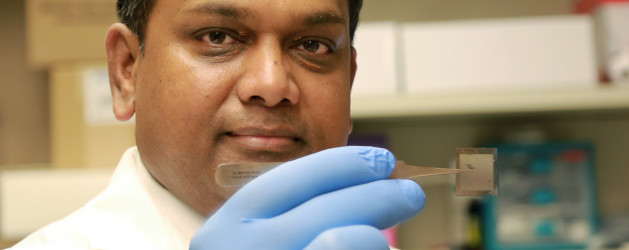This technology of Regenerative Medicine, known as Tissue Nanotransfection (TNT), has the potential to save and improve many lives. Victims of car crash and even deployed soldiers injured on the battle field suffering from Traumatic Brain or Spinal Cord Injuries. It’s a dime-sized silicone chip that “injects genetic code into skin cells. Turning those skin cells into other types of cells required for treating diseased conditions.”
It takes just a fraction of a second to simply touch the chip to the wounded area and then remove it. At that point, the cell reprogramming begins. According to Chandan Sen, PhD, director of the Center for Regenerative Medicine and Cell-Based Therapies at The Ohio State University Wexner Medical Center.
Lab Testing
In a series of lab tests, Regenerative Medicine researchers applied the chip to the injured legs of mice. Their vascular scans showed had little to no blood flow. “We reprogrammed their skin cells to become vascular cells,” Sen said. “Within a week we began noticing the transformation.”
By the second week, active blood vessels had formed through the use of TNT Regenerative Medicine. By the third week, the legs of the mice were saved—with no other form of treatment.
It extends the concept known as Regenerative Medicine gene therapy, and it has been around for quite some time. According to study collaborator James Lee, PhD, a professor of chemical and biomolecular engineering at Ohio State. The difference with this technology is how the DNA is delivered into the cells.
The chip, loaded with specific genetic code or certain proteins, is placed on the skin.Then a small electrical current creates channels in the tissue. The DNA or RNA is injected into those channels where it takes root and begins to reprogram the cells.
In a new study published in Nature Nanotechnology, first author Daniel Gallego-Perez of Ohio State demonstrated that the technique worked with up to 98 percent efficiently.
Future Prospects
What’s even more exciting is that this Regenerative Medicine not only works on the skin, but on any type of tissue. During the researchers they were able to grow brain cells on the skin surface of a mouse. Harvest them and then inject them into the mouse’s injured brain. Just a few weeks after having a stroke, brain function in the mouse was restored, and it was healed.
This technology does not require a laboratory or hospital and can actually be executed in the field. It’s less than 100 grams to carry and will have a long shelf life.
This Regenerative Medicine approach is currently awaiting FDA approval. Sen, who has been working on this for four years, expects TNT will be tested on humans within the year. He says he’s talking with Walter Reed National Medical Center now.
“We are proposing the use of skin as an agricultural land where you can essentially grow any cell of interest,” Sen said.
Because the technique uses a patient’s own cells and does not rely on medication. The Regenerative Medicine researchers expect it to be approved for human trials within a year.
The horizon for utilization of TNT Regenerative Medicine encompasses the ability to repair, supplement and replace any damaged part of the human body without invasive surgical procedures. The severed or damaged nerves occurring when someone suffers a Spinal Cord Injury can be repaired within several weeks. Restoring full functioning to wheel chair and bed ridden patients.
Patients that have had Traumatic Brain Injuries will now be able to benefit from TNT Regenerative Medicine in a dramatic fashion. Their own brain cells regenerated to replace the damaged areas without the concern of rejection from their system. This allows patients to go forward leading a normal life again and not even worry about taking anti-rejection medication for the rest of their life.
Sources:
Ohio State University – https://news.osu.edu/news/2017/08/07/regenerative-med-study/
Nature Nanotechnology _ http://www.nature.com/nnano/index.html?foxtrotcallback=true

